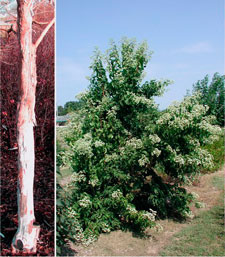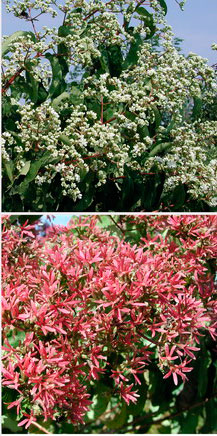Resource Library
Plant of the Week: Seven-Son Flower
The University of Arkansas System Division of Agriculture does not promote, support or recommend plants featured in "Plant of the Week." Please consult your local Extension office for plants suitable for your region.
Plant of the Week
Seven-Son Flower
Latin: Heptacodium miconioides

The introduction of completely new shrubs and trees into the garden is a rare event because the temperate world has been pretty well scouted by plant collectors during the past several centuries. But it still happens as is evidenced by the 1980 introduction of seven-son flower, Heptacodium miconioides, from China.
Heptacodium is shrubby plant belonging to the honeysuckle family native to at least two provinces in southern and south-central China. Like most members of the honeysuckle family, it grows as a multi-stemmed shrub with long branches that arch outward as the plant ages. Plants can reach 15 to 20 feet tall with a spread of 10 to 15 feet. As the plants age, the bark begins to peel (exfoliate), revealing a brownish to gray-white display. This characteristic has given rise to one of its American common names, “hardy crapemyrtle.”
Plants leaf out early and produce a heavy crop of deep green, opposite, 3- to 4-inch long leaves that have three prominent veins running the length of the leaf. Though they have no fall color, Heptacodium leafs out early and holds its foliage late.
The real selling point of this shrub is the heavy crop of white flowers that appear in August. The individual flowers are small (one-quarter inch), five-lobed, but borne in 6-inch long panicles above the foliage, and form an effective display. Each panicle segment ends in a cluster of seven buds. It’s from these buds that both the Chinese common name and the Latin name originate. On my plant, the central flower bud doesn’t open; instead, the six outer buds open in succession forming a whorl about the size of a nickel. The bloom display remains effective for about three weeks.
In late August, the flowers fade away and are forgotten, only to be resurrected again in a few weeks as the seed capsules ripen. Like the glossy abelia, also a member of the honeysuckle family, each seed capsule is surrounded by a cluster of five reddish-purple to rose-colored calyces, which continue to grow as the capsule matures. These are showier than the flowers and persist for several weeks. The calyx display gives rise to the common name “autumn lilac.”

Heptacodium was first collected in China in 1907, but it was not introduced into cultivation in the West until 1980 after members of the Sino-American Botanical Expedition collected seeds in a southern Chinese botanical garden. This team was the first group of western botanists allowed in China since 1945 when the Communists defeated the Nationalists and Chairman Mao assumed control of the nation. The Arnold Arboretum made a general release of plants in 1987.
The shrub form of Heptacodium has potential in larger landscapes where masses of viburnums might be grown. But most gardeners will probably more easily accommodate it if it’s grown as a single- or multiple-trunked small tree and used as a small specimen near an entryway or patio. To accomplish this look pruning must begin early with the selected trunk(s) limbed up to the desired height. Suckers will be more or less a continual problem until the main stems are well established.
Heptacodium grows in full sun or light shade in a wide range of soil types. It has a moderate growth rate and is considered easy to grow. Five-year-old plants will be 10 to 12 feet tall in an area with a long growing season. It’s considered winter hardy from zones 5 to 8.
By: Gerald Klingaman, retired
Extension Horticulturist - Ornamentals
Extension News - September 21, 2007
The University of Arkansas System Division of Agriculture does not maintain lists of retail outlets where these plants can be purchased. Please check your local nursery or other retail outlets to ask about the availability of these plants for your growing area.